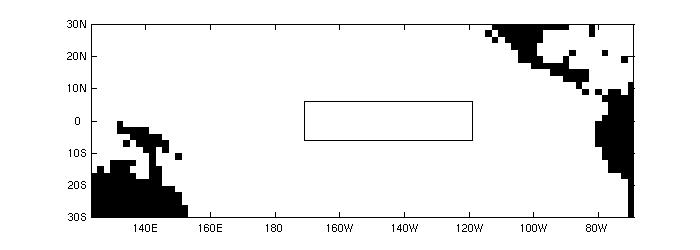HiDyn-model forecasting of SSTs - background details
 Tropical Pacific Region of Interest with Nino 3.4 Region Outlined
Tropical Pacific Region of Interest with Nino 3.4 Region Outlined
The interannual variation of tropical Pacific sea surface temperature (SST) is an important factor in the variability of the global climate system. The dominant feature of this field is the episodic warming and cooling of ocean waters with periods of approximately 3-5 years, namely, the El Nino Southern Oscillation (ENSO) phenomenon. In recent years, long-lead predictions of tropical Pacific SSTs have improved greatly in light of better observational networks, analysis schemes, and understanding of the processes that govern the interaction of the atmosphere and ocean. Although statistical methods for SST prediction have performed as well or better than deterministic, physically derived dynamical methods (Barnston et al., 1999), there is often a perception in the climate community that much of the potential of statistical models has been exhausted. Of course, such suggestions refer to a collection of particular forms of statistical models; our approach is based on an alternative, Bayesian statistical formulation and prediction procedure that expresses a variety of qualitative notions and principles present in the literature regarding SSTs and their evolution. The Bayesian approach also allows for the quantification of uncertainty related to our physical understanding and its stochastic representation. That is, we build a Bayesian Hierarchical Dynamic Spatial Model to forecast SSTs in the Tropical Pacific Ocean. In all subsequent discussion, we refer to these models as HiDyn Models.
Our model is "statistical" in that, although it is guided by a qualitative expression of the physics, no formal physical model is included. This is not a limitation of the Bayesian approach. See Royle et al. (1998) and Wikle et al. (2001) for examples of Bayesian analyses relying on physical models. Indeed, the Bayesian statistical view does not recognize a strict dichotomy between statistical and deterministic approaches. It offers opportunities to incorporate deterministic models into statistical long-lead SST forecasting, in a fashion that accounts for a variety of uncertainties. Furthermore, Bayesian predictions and associated uncertainties are efficient inputs to decision-making and forecasting the impacts of SST behavior. (See Berger, 1985, and Bernardo and Smith, 1994, for a general discussion of Bayesian statistics.)
Many of the long-lead statistical prediction schemes for SSTs that have been used to date have focused on relatively simple linear models (Barnston et al., 1999). The statistical sciences have undergone a dramatic change in recent years as computationally based nonlinear methodologies have been developed and applied in complex settings. In particular, the hierarchical Bayesian statistical paradigm has benefited from this revolution. The tropical-Pacific-SST-forecasting problem provides an exceptional context in which to demonstrate the long-lead predictive power of, and associated quantification of uncertainties possible with, a statistical approach based on HiDyn Models.
The HiDyn Model that we have developed forecasts a spatial field of monthly tropical Pacific SST anomalies at a seven-month lead time. This lead time was chosen to demonstrate how the methodology could be applied to produce operational forecasts at least six months in advance, with the consideration that time is required to acquire new data for the new forecast. The methodology can be readily adapted to different lead times. The mathematical details can be found in Berliner, Wikle, and Cressie (2000); key to the HiDyn Model is incorporation of the following technical features:
- For each time (month) we consider a spectral model for the data, focusing on a reduced empirical orthogonal function (EOF) basis set.
- We assume that the spectral coefficients of the model are stochastic and time-varying. That is, they are assumed to follow a multivariate time-series model.
- The parameters of that time-series model are themselves time-varying, yielding a methodology that is inherently nonlinear. Models reflecting warm, normal, and cool regimes are considered.
- Prognostic variables that indicate possible future transitions among regimes are modeled as random with probabilities that depend upon the behavior of surface-wind anomalies in the western Pacific, which is a qualitative expression of physical processes associated with tropical Pacific SSTs.
Variabilities inherent in the various processes are included in the HiDyn Model, and the SST-anomaly forecasts are obtained with these variabilities properly accounted for. Furthermore, we note that since the HiDyn Model is a desktop workstation model, achieving even comparable results to deterministic models run on supercomputers represents a significant advance relative to computational effort.
As a disclaimer, this HiDyn Model may not give dramatically superior forecasts to existing ones, but it is the first to quantify properly the variability in the forecasts. There is much more that could be done to the present HiDyn Model to improve it, as is noted throughout the exposition of Berliner, Wikle, and Cressie (2000).
(Based on material presented in Berliner, Wikle, and Cressie, 2000.)